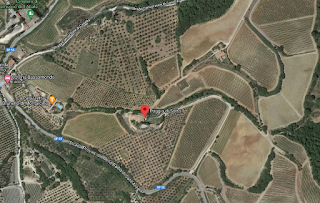Poggio di Sotto has been described as "the most Burgundian of the Brunellos" and as one of the two Montalcino "First Growths" (the other being Soldera). It is most definitely one of my favorite Brunello di Montalcino wines.
The estate was founded by Piero Palmucci (a former shipping executive) who, once he decided to make a Sangiovese wine, invested the time seeking out the best locale, and sites within that locale, to support the variety. He found that locale just outside the town of Castelnuevo dell'Abate, the site that is the home of Poggio di Sotto. The estate began operation in 1989.
After the launch of the estate, Piero initiated a collaboration with the University of Milan with the intent of identifying the finest Sangiovese clones and optimizing the vineyards (in terms of planting density and pruning practices). The end result was an organically farmed vineyard that served as the launch pad for one of the great Brunello di Montalcino wines. Piero was ably assisted in his efforts by the famed (now deceased) consulting enologist Giulio Gambelli.
Poggio di Sotto was sold to Claudio Tipa of Colle Massari Wine Estates in 2011 under the condition that the new owner "retain and respect the same quality standards and production techniques" that are the foundation of the estate's success and reputation.
The estate is located on a 40-ha (108-acre) plot with 16-ha currently planted to vines and the remainder dedicated to olive groves and forests. The property is located on high hills overlooking the Orcia river valley. Its three vineyard parcels are located on steep (10% gradient), south-facing slopes at 200, 300, and 450 m elevation, respectively.
 |
| Satellite view of Poggio di Sotto (Google Maps) |
The warm Montalcino climate is moderated by the Orcia River and cooling breezes from Mt Amiata across the valley. The soil is rocky, with gravel and clay in the lowest parcels giving way to sandy clay at higher elevations.
The vineyards are planted to Sangiovese at densities ranging between 3000 and 4200 vines/ha. The vines, which are spurred-cordon trained, average 20 years of age.
The production of low-yield, high-quality wine is kicked off with two green harvests; the first in June, the second in late July/early August. Grapes are harvested manually with yields falling between 3 and 3.5 tons/ha.
The estate produces two or three wines per harvest, depending on the year: a Brunello di Montalcino, a Rosso di Montalcino, and, in good years, a Brunello di Montalcino Riserva. The production characteristics of each wine is provided in the table below.
|
Wine |
Fermentation Vessels |
Yeast |
Length |
Cap Management |
MLF |
Aging |
|
Brunello di Montalcino |
70 hl Slavonian oak vats (4 - 12 years old) |
Indigenous |
30 - 35 days |
Pump over |
Yes |
40 months in 25 - 35-hl Slavonian oak botti; 12 months in bottle |
|
Brunello di Montalcino Riserva |
70 hl Slavonian oak vats (4 - 12 years old) |
do. |
do. |
do. |
Yes |
60 months in 25 - 35-hl Slavonian oak botti; 12 months in bottle |
|
Rosso di Montalcino |
Stainless steel and oak tanks |
do. |
do. |
do. |
Yes |
24 months in 25 - 35-hl Slavonian oak botti; 6 months in bottle |
I have consumed a few bottles of these wines in the past and characterize a subset below. Many of these wines were tasted with my buddy Ron Siegel and I have incorporated his notes in those cases.
The 2005 showed herbs and red fruit on the nose. It was medium-bodied, rich and balanced on the palate.
 |
| The 2005 Poggio di Sotto Brunello di Montalcino |
 |
| Riserva 2006 |
The 2007 was rich and full-bodied, showing beautiful aromatics of dark fruits of cherry and currant with leather, tobacco leaf, florality, licorice, and spice. Layered, with soft tannins. Balanced. Lengthy finish.
 |
| 2007 |
The 2008 showed ripe cherries and strawberry with a perfumed nose of earth, crushed rock, licorice, underbrush, dried rose petal, and tobacco. Medium acidity and tannins. Earth notes. Balanced, with a lengthy finish.
 |
| 2008 |
Ripe red fruit, florality, mint, coffee, tobaco, and spices on the nose. Fruit character comes through on the palate. Elegant and complex. Lengthy finish.
 |
| Riserva 2008 |
Red berries, mint, and florality on the nose. Layered and elegant. Well integrated tannins with medium levels for both tannins and acidity. Balanced.
 |
| 2009 |
Ripe red cherries and berries along with earth and herbs on the 1997. Perfumed. Medium bodied. Lengthy finish.
 |
| 1997 |
The 1996 showed perfumed dark berries on the nose along with herbs, cinnamon on the palate. Medium acidity and a long finish.
 |
| 1996 |
These wines are a pleasure to drink with elegance, balance and long finishes as hallmarks. I am looking forward to my next fix.
©Wine -- Mise en abyme

No comments:
Post a Comment